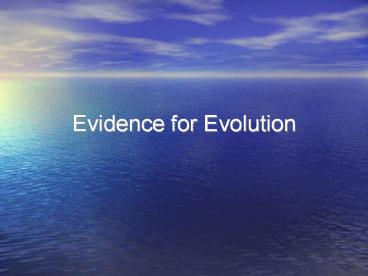Evidence for Evolution - PowerPoint PPT Presentation
1 / 9
Title:
Evidence for Evolution
Description:
Evidence for Evolution Biogeography The study of geographic distribution of organisms based on both living species and fossils. Remote islands have unusual examples ... – PowerPoint PPT presentation
Number of Views:83
Avg rating:3.0/5.0
Title: Evidence for Evolution
1
Evidence for Evolution
2
Biogeography
- The study of geographic distribution of organisms
based on both living species and fossils. - Remote islands have unusual examples of animal
behaviour. A lot of the animals are fearless
perhaps lost their instinctive fear because they
had no natural predators. - All 99 lemur species live on the island of
Madagascar, but there are fossils of lemur in
India.
3
Darwins Hypotheses
Observations Hypotheses
Many species of plants, birds, insects Only these kinds of organisms can reach remote islands by crossing open waters
No native amphibians, few land mammals They were not able to cross water.
Unique species found nowhere else on Earth Over time, ancestral species evolved into new geographically isolated species.
Unique species resemble species on nearest continental land mass Unique species are descendents of ancestral species from continental land mass
4
Homologous Features
- A structure with a common evolutionary origin
that may serve different functions in modern
species. - Example human arm, horses leg, cats leg, bats
wing, whales flipper. - Example all mammals have 28 skull bones, 7 neck
bones. - Why were the bones in all mammals so similar?
- Perhaps they share a common ancestor.
- Homologous developmental structures and
processes human embryos possess a short bony
tail and gill slits.
5
Analogous Features
- Structures that perform the same function as
another but is not similar in origin or
anatomical structure. - Example insect wings and bird wings.
- These structured evolved independently from one
another.
6
Vestigial Features
- Rudimentary and non-functioning structures that
are homologous to a fully functioning structure
in a related species. - Examples pigs extra two toes, dogs dew claws,
some whales and snakes have vestigial hip bones. - Can be linked to a common ancestor
- Humans have goosebumps that are muscles which
raise hairs in response to cold temperatures, but
it doesnt actually make us warmer because our
hair is too sparse!
7
Competition
- Darwin wondered if nature might be able to favour
certain individuals in a population over others. - Darwin read a mathematics paper by Malthus called
Essay on the Principle of Population - All populations were limited in size by their
environment (food supply, shelter) - Darwin figured that there must be competition
between organisms of different species and of the
same species for survival. - The organisms best suited for their environment
will survive. Thus the term survival of the
fittest!
8
Natural Selection
- Darwin published On the Origin of Species in 1859
after 20 years of amassing evidence. - Waited so long because his data was very
controversial. But he got a letter from a young
Alfred Russell Wallace that was a match to
Darwins theory, so Darwin knew he needed to
publish his theory quickly. - Natural selection the way in which nature
favours the reproductive success of some
individuals within a population over others. - Evolution was the result of natural selection
occuring over many generations.
9
Darwins 5 Key Observations
- In each generation, populations produce more
offspring than there are adults - Populations do not continue to grow in size.
- Food and many other resources are limited
- Individuals within a population vary.
- Many variations are heritable.

